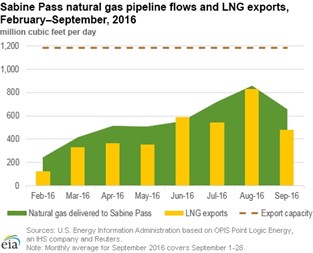EIA: Sabine Pass liquefaction terminal begins first maintenance

Graphic courtesy of the US Energy Information Administration.
The Sabine Pass liquefaction terminal, the first LNG facility in the Lower 48 states, began planned maintenance of Trains 1 and 2, the only fully operational trains, on September 20. The maintenance was scheduled to improve performance of the wet/dry flare systems that Trains 1 and 2 share. Both liquefaction trains will be completely shut down during maintenance, which is expected to last approximately four weeks.
Natural gas pipeline deliveries to Trains 1 and 2 increased in the first two weeks of September, averaging 1.2 Bcfd, prior to the maintenance startup. This was done to fill the terminal's storage tanks to nearly full capacity as this allows LNG to be held for longer periods by reducing the amount of boil-off.
During maintenance, the terminal may still receive nominal natural gas deliveries ranging from 10 MMcfd to 100 MMcfd as part of the commissioning of Train 3. The commissioning of Train 3 began on August 19, after the terminal operator, Cheniere, received the necessary approval from the Federal Energy Regulatory Commission (FERC). The terminal needs these nominal deliveries to conduct pressure tests of the compressors and to ensure all equipment is working properly in preparation for liquefaction. Train 3 is expected to begin liquefying natural gas after it receives FERC authorization to introduce refrigerants to the system, and is targeted for substantial completion by June 2017.
Since the first cargo left Sabine Pass on February 24, an estimated 113 Bcf of LNG has been exported on 33 tankers from Trains 1 and 2 to 12 countries worldwide. More than half of the US LNG exports so far were shipped to South America and the Caribbean (Brazil, Argentina, Chile, and the Dominican Republic), followed by Asia (India and China), the Middle East (United Arab Emirates, Kuwait, and Jordan), a small volume to Europe (Portugal and Spain), and Mexico. Sabine Pass is a six-train facility with a capacity of 0.59 Bcfd for each train. Trains 4 and 5 are under construction, and Train 6 has been fully permitted.

- Gasum powers Equinor's platform supply vessel with bio-LNG
- ADNOC deploys pioneering AI-enabled process optimization technology
- Mexico Pacific announces long-term LNG SPA with POSCO International
- ONEOK to acquire Medallion and controlling interest in EnLink for $5.9 B
- Golar LNG signs EPC deal for $2.2-B MK II FLNG conversion project



Comments